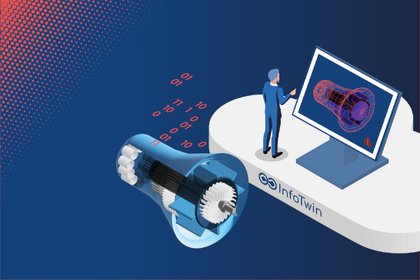Predictive Maintenance in Machine Construction: The Prerequisites and Advantages
Plant operators need durable, reliable machines in order to cut costs and improve sustainability. Predictive maintenance allows plant and equipment manufacturers to meet these demands. In this post from our “Buzzwords Explained” series, we demonstrate how predictive maintenance works and what benefits it can have for you.
Definition: What is predictive maintenance?
Servicing and maintenance measures are essential for machines to operate safely and reliably. Predictive maintenance is a concept that promises efficiency and cost savings for servicing and is regarded as a key technology for Industry 4.0.
Predictive maintenance is a proactive maintenance process which involves permanent monitoring and evaluation of machines and process data. The data gathered is used to predict the future maintenance requirements of components and entire systems, with the goal of preventing faults and unplanned downtime as well as making maintenance processes more efficient.
Difference between preventive maintenance and predictive maintenance
There are several different types of maintenance strategy, with the three most common being:
- Reactive maintenance, which corrects existing problems
- Preventive maintenance, which prevents problems arising through regular servicing
- Predictive maintenance, which predicts errors or faults as accurately as possible so that they can be promptly resolved
Preventive maintenance is centered around the average or expected service life of a device, machine, or system. It is based on routines, where items such as wear parts are regularly replaced, even if they are still working.
It is much more effective to use the actual status of machines as an indicator for the correct maintenance date, meaning that service technicians only need to replace parts when they are at a genuine risk of failing.
How does predictive maintenance work?
To carry out predictive maintenance, you need to collect and evaluate big data to assess the actual condition of a device. Various inspection processes can help with this, where infrared technology, vibration analyses, acoustic or sound level measurements can be used to measure temperatures, rotational speeds, sounds, or runtimes, for example.
Technology from the big data environment, such as real time analytics, helps monitor and analyze the current condition of devices, machines, and systems (condition monitoring).
This data is then fed into a centralized piece of software alongside additional information such as:
- Environmental and location data
- Information about previous machine failures and faults
- Repairs already performed
Conclusions can then be drawn about what maintenance is to be expected in future and predict the best time to carry out servicing. Ideally, the maintenance technician will service a device before it develops a fault or fails – but also only when it is really necessary.
The three pillars of predictive maintenance
Simply put, predictive maintenance rests on three pillars:
- Permanent or periodic collection and storage of machine and process data
- (Automatic) analysis and evaluation of the data
- Calculation of the probability of occurrence of certain events
Data is the key to proactive maintenance. Read our free white paper on smart information and how data can help ensure efficient maintenance.
Benefits of predictive maintenance at a glance
Machine manufacturers and system operators benefit from the correct application of predictive maintenance in many ways:
- Reduction in downtime
- Fewer unplanned stoppages
- Increased service life of machines and systems
- Calculation of the optimum maintenance time
- Prevention of unnecessary routine maintenance
- Improved resource scheduling and reduction in workload for maintenance and service technicians
- Efficient spare parts management
- Improved productivity and machine performance
What's more, a predictive maintenance strategy is a key prerequisite for new business models. If you offer your customers equipment as a service, for example, you must be able to ensure the smooth operation of your products.
Predictive maintenance also plays a key role in increasing sustainability by extending the service life of systems. Cost savings from the reduction in expensive downtime are another major advantage for you and your customers.
How do industrial companies benefit from predictive maintenance?
According to a 2021 survey by Bearing Point, the companies surveyed were able to reduce their machine and system downtime by 18 percent thanks to predictive maintenance. Maintenance and servicing costs fell by 17 percent. Those surveyed also estimated that their predictive maintenance projects led to a 10 percent increase in turnover on average.
How to efficiently introduce predictive maintenance
In order for the maintenance to be “predictive” and the calculations to be as accurate as possible, users need huge volumes of data. Predictive maintenance systems are therefore ideal for companies with a large number of one type of machine.
What's more, predictive maintenance offers advantages for manufacturers who want to use it not only for their own machines but also for machines sold to customers.
Whether or not the maintenance methods are suitable for any particular company depends on a range of factors, such as:
- Resources: The number and diversity of the machines in use
- Costs: The number and severity of faults to date
- Time: Planned duration of use of the machines
Implementation: Six steps to predictive maintenance
If you want to implement a predictive maintenance solution, you need to take the following six steps:
- Prioritize your applications. Machines that are particularly expensive, break down frequently, or lead to high costs when they do fail are suitable for predictive maintenance.
- Equip the devices with sensors that will help you to monitor them. The earlier they are equipped with sensors and networked with one another, the more data – and above all historic data – will be available for further evaluation.
- Collect and store data periodically or continually. As well as status data such as temperature or static properties such as the manufacturing date, event-related data is also relevant for condition monitoring. This may include information on repairs or other service data. All this data should be stored in a central system, so that you have a 360-degree view of your devices, machines, and systems.
- Prepare the collected data. This includes cleaning data records, deleting incorrect values, and adding missing values.
- Analyze and interpret the data (automated). The important questions here are: Which measurements are relevant for the machine? Which status data will tell us which component might fail in the foreseeable future? Which threshold values are relevant for which data types? When evaluating the collected data, algorithms, machine learning, and artificial intelligence (AI) are all useful. These make it easier to identify the correlations.
- Identify the maintenance requirements and necessary wear and spare parts and plan your maintenance tasks with foresight.
Important: Be patient. The longer a predictive maintenance algorithm is used, the better it will understand the monitored devices and processes. The algorithm is continually learning and in time can make increasingly more accurate conclusions about possible failures. Predictive maintenance should therefore be viewed as a long-term maintenance strategy.
Lay the foundation for predictive maintenance now!
With a central portal for all maintenance and service information, you can create a comprehensive, digital understanding of your machine and systems – and therefore lay the basis for implementing predictive maintenance. With the aid of such a system, you can build a digital information twin for your products – an intelligent data model which serves as a digital information twin for your machines and systems.
By linking IIoT data from the sensors with stock levels and spare parts, you can optimize your processes and maintenance, reduce costs and downtime for yourself and your customers, and make sure your company is optimally positioned for the future.
Are you looking for the right system? Our aftersales platform Quanos InfoTwin can help you with your optimization plans for servicing and maintenance.




